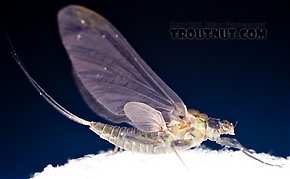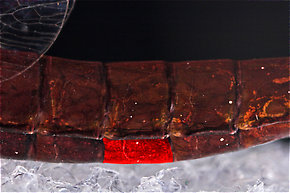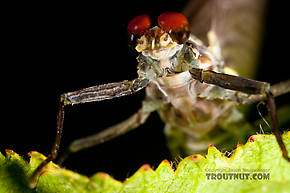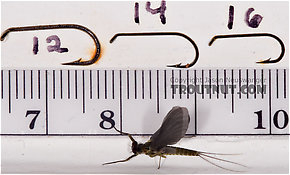Blog & Latest Updates
Fly Fishing Articles
Insects by Common Name


Mayfly Genus Drunella (Blue-Winged Olives)
Taxonomic Navigation -?-
Kingdom
Animalia (Animals)
» Phylum
Arthropoda (Arthropods)
» Class
Insecta (Insects)
» Order
Ephemeroptera (Mayflies)
» Genus Drunella (Blue-Winged Olives)
1 species isn't included.
Common Name
| Match | Common Name |
| Blue-Winged Olives |
In the East, there are the morning hatches of Drunella cornuta (Large Blue-Winged Olive) followed as the season progresses by the smaller Drunella cornutella and Drunella lata species, both commonly called Little Blue-Winged Olives. These hatches usually begin in late spring and can continue well into midsummer on many Eastern and Midwestern streams.
In the West, the Drunella genus is even more prominent. Besides having abundant Blue-Winged Olive hatches represented by the common species Drunella coloradensis (Little Western Green Drake), Drunella spinifera (Western Slate-winged Olive Dun) and Drunella flavilinea (Western Blue-winged Olive or "Flav") the region also has the Drunella group of famous Western Green Drakes made up of the curious flat-faced nymph species Drunella doddsii and the three subspecies (Subspecies: Entomologists sometimes further divide a species into distinct groups called subspecies, which have two lower-case words on the end of their scientific name instead of one. The latter is the sub-species name. For example, Maccaffertium mexicanum mexicanum and Maccaffertium mexicanum integrum are two different subspecies of Maccaffertium mexicanum.) of Drunella grandis. Coloration ranges widely by region, going from dark brown to bright green. Most commonly they will be in the olive range. The wings too can range from dark slate to medium dun, often with yellow or olive pigment in the basal (Basal: close to the base; root or beginning) costal region (lower leading edge) of the forewings.
There have been many changes in taxonomic nomenclature affecting the Ephemerellidae over the years with few impacted more than the species of this genus. Anglers interested in "connecting the dots" with entomological information provided in fishing literature of the past need to take note of this.
Hatching Behavior
Like the rest of the Ephemerellidae, they are classic surface emergers with long sedate floats in optimal weather and often engage in "practice runs" exposing the nymphs to trout during extended pre-hatch periods. But more so than others, this genus seems to have a greater propensity to emerge subsurface somewhere in the top 12 inches of water even in slower currents. They often arrive on the surface bedraggled and ride its currents for a long time before their wings are ready for flight.
Some species in this genus tend to change color dramatically as soon as they hit the air, and it's often important to imitate the bright greens the trout see in the "fresh" duns rather than the muted shades of olive or ruddy brown that we find when collected later.
Spinner Behavior
The spinners (imagos) of this group are typically various shades of brown or darker versions of the duns (subimagos) with clear glassy wings. Their egg masses are typically very dark olive to almost black which is another identifying characteristic separating them from all but a few important Ephemerellidae. The spinner falls can be important or unimportant, depending on species, location and circumstances.
Nymph Biology
Diet: Herbivorous; Carnivorous?
With a few exceptions, Drunella nymphs can be easily differentiated from other ephemerellid nymphs without the aid of magnification. A telltale sign is the husky crablike forelegs that often have visible serrations along the leading edge of the forefemur. Another indicator is the existence of horns, tubercules and/or spiky projections on various parts of the body. On some species they can be a little difficult to make out, others will look like miniature Horned Toads or something out of a Godzilla movie. All are stouter than most other ephemerellids to varying degrees. They can be confused with heptageniid clinger nymphs when viewed from above, though their smaller ephemerellid heads and fuller lateral (Lateral: To the side.) profiles should help the observant angler from making that mistake. Some of the larger species have been reported to consume other nymphs in their final stages of development.Pictures of 51 Mayfly Specimens in the Genus Drunella:
Female Drunella tuberculata Mayfly Dun View 14 PicturesI don't know for sure that this is Drunella tuberculata, but that's my best guess for now.
View 14 PicturesI don't know for sure that this is Drunella tuberculata, but that's my best guess for now.
It certainly has a different look and much more robust body shape from Drunella lata duns I photographed a couple weeks earlier, so I doubt it's that species. Using distribution records to eliminate other choices narrows this down to Drunella tuberculata or Drunella walkeri.
Markings described for the abdominal sternites ( Sternite: The bottom (ventral) part of a single segment on an insect's abdomen.) of the male spinner of Drunella tuberculata are suspiciously similar to those on this female dun. Also, this dun is 9.5mm long (my ruler pic isn't very good, but I'm basing this on measuring the real thing). The size range given in the old Allen & Edmunds keys for walkeri females is 7-8mm, while tuberculata is 9-11mm. For these reasons I'm sticking it in tuberculata for now.
Sternite: The bottom (ventral) part of a single segment on an insect's abdomen.) of the male spinner of Drunella tuberculata are suspiciously similar to those on this female dun. Also, this dun is 9.5mm long (my ruler pic isn't very good, but I'm basing this on measuring the real thing). The size range given in the old Allen & Edmunds keys for walkeri females is 7-8mm, while tuberculata is 9-11mm. For these reasons I'm sticking it in tuberculata for now.
This is the only Drunella mayfly I saw all day. I scooped it off the water as it emerged at around 7pm from a big Catskill tailwater.
 View 14 PicturesI don't know for sure that this is Drunella tuberculata, but that's my best guess for now.
View 14 PicturesI don't know for sure that this is Drunella tuberculata, but that's my best guess for now. It certainly has a different look and much more robust body shape from Drunella lata duns I photographed a couple weeks earlier, so I doubt it's that species. Using distribution records to eliminate other choices narrows this down to Drunella tuberculata or Drunella walkeri.
Markings described for the abdominal sternites (

One sternite of this Isonychia bicolor mayfly spinner is highlighted in red.
This is the only Drunella mayfly I saw all day. I scooped it off the water as it emerged at around 7pm from a big Catskill tailwater.
Collected June 1, 2007 from the West Branch of the Delaware River in New York
Added to Troutnut.com by Troutnut on June 8, 2007
Added to Troutnut.com by Troutnut on June 8, 2007
Male Drunella doddsii (Western Green Drake) Mayfly Dun View 13 Pictures
View 13 Pictures
 View 13 Pictures
View 13 PicturesCollected July 17, 2011 from the Gulkana River in Alaska
Added to Troutnut.com by Troutnut on July 20, 2011
Added to Troutnut.com by Troutnut on July 20, 2011
Male Drunella cornuta (Large Blue-Winged Olive) Mayfly Dun View 12 Pictures
View 12 Pictures
 View 12 Pictures
View 12 PicturesCollected May 29, 2007 from Brodhead Creek in Pennsylvania
Added to Troutnut.com by Troutnut on June 4, 2007
Added to Troutnut.com by Troutnut on June 4, 2007
Recent Discussions of Drunella
Drunella cornuta on the Brodhead at Stroudsburg PA 11 Replies »
Posted by Reify on Apr 21, 2014 in the species Drunella cornuta
Last reply on Apr 24, 2014 by Brookyman
4/21/14 - Fished the Brodhead today at the last park before last bridge on PA 191 - downstream of huge riffle section so is a great tretch for this species. I didn't get there until around 1:00 PM, took a nap and started fishing at 2:00 and there were still cornuta coming off sparsely but steadliy - until 3:30 PM. Sparse rises, but I was entertained. Is that normal or could it be because the water is unusually cold this year. Are the males and females of the same size or is one larger - and of slightly more pale coloration at take-off from surface? It almost looked to me to be two different flies, but I'm sure they weren't.
ReplyDrunella in the Smokies 6 Replies »Posted by Konchu on Sep 20, 2009 in the species Drunella tuberculata
Last reply on Jan 4, 2010 by Konchu
Just got back from a trip to the North Carolina side of the Smokies. Drunella tuberculata (probably the conestee form) is getting ready to hatch there. Most of the other bugs of decent size that I saw were relatively young.
ReplyMidwest Lata Emergence 20 Replies »Posted by DarkDun on Mar 4, 2007 in the species Drunella lata
Last reply on May 2, 2007 by Taxon
The D.Lata emerges in Michigan waters at 10 AM on the dot and stops at noon from about June 25 thru July 10. I have fished this hatch avidly for years and find it very punctual on moderately overcast days. Sunny days make it much shorter duration, about 30 minutes. A size 14 imitates it perfectly with dark dun wings, bright olive green body and med dun tails and legs at emergence. The body color does change to dark green after a while.
The D.Lata also is significant in PA Northern Streams in Mid May.
I have not encountered it in the South Appallacian streams as yet. I fish some smaller BWO (#16-20) in NC but none so large as D. Lata.
ReplyThe D.Lata also is significant in PA Northern Streams in Mid May.
I have not encountered it in the South Appallacian streams as yet. I fish some smaller BWO (#16-20) in NC but none so large as D. Lata.
Your Thoughts On Drunella:
Top 10 Fly Hatches
Top Gift Shop Designs
Eat mayflies.
Top Insect Specimens
Miscellaneous Sites
Troutnut.com is copyright © 2004-2024 Jason
Neuswanger (email Jason). See my FAQ for information about use of my images.
 privacy policy
privacy policy
